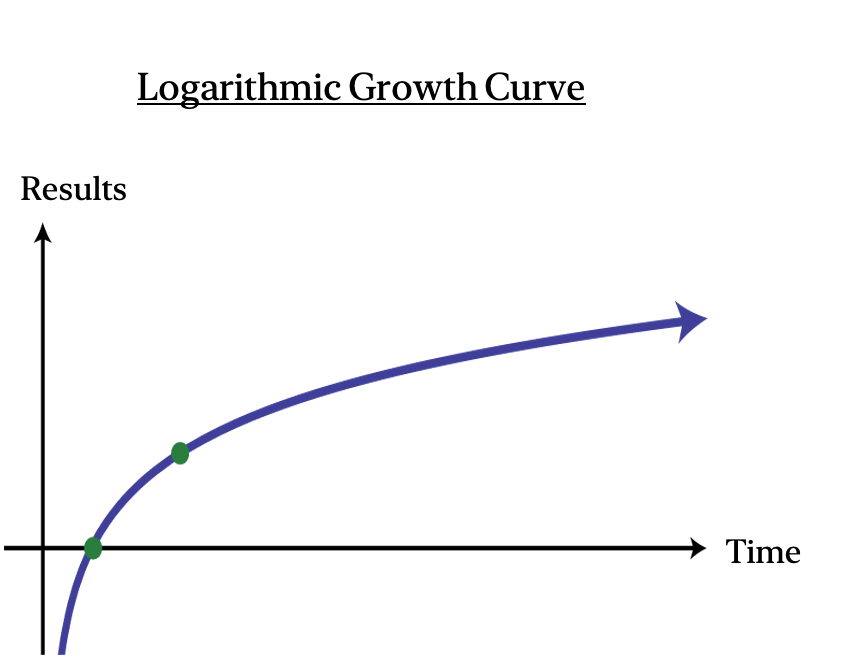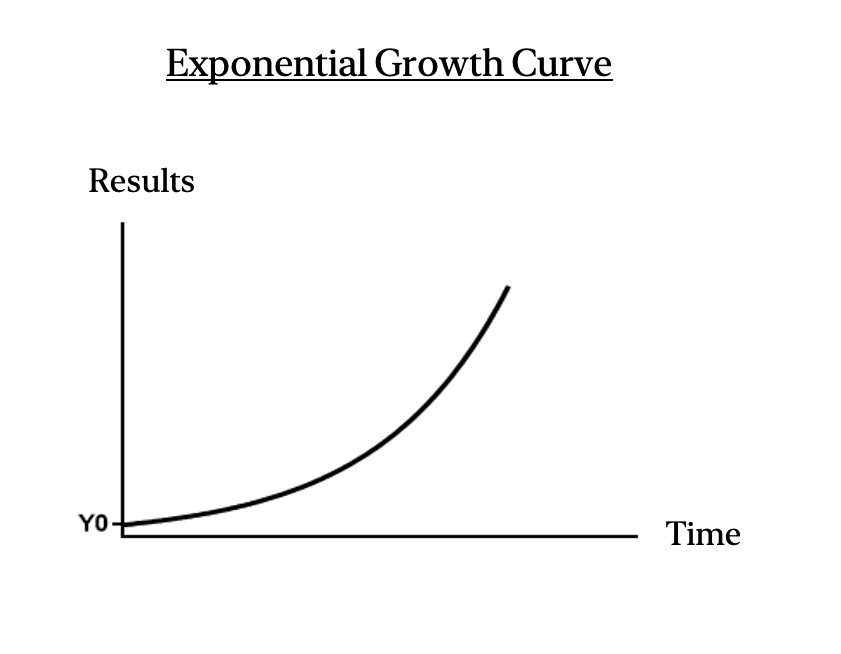
Linear. Logarithmic. And Exponential Curves. These three curves explain the different types of growth in life (finance, maturity, health, knowledge, skills, etc.), help you identify the growth curve you are following — and help maximize your success.
Most of us often believe that growth works linearly. For instance, if I work for 1 hour I get paid $10, if I work 2 hours, I get paid $20 in total. While this belief is not entirely wrong, it is not comprehensive. Linear growth is a very theoretical concept and for instance, it fails to explain why learning a skill is not directly proportional to the hours invested in practicing it. In addition, it is unable to explain growth in the aspect of wealth.
Logarithmic Growth Curve with Results as the y-axis and Time as the x-axis
This is where the logarithmic curve comes in. Mathematically, a logarithmic curve means that the y value is increasing at a decreasing rate as the x value increases. Thus, initially, you are experiencing a lot of improvement in a short span of time. However, as time progresses, you find it harder to progress and see noticeable results. This is often the case when learning a new skill like mastering a new language or being good at a sport.
I faced this situation when I was learning basketball. When I first started, my handles and shooting improved rapidly just after playing for a couple of weeks. However, as months go by, my basketball skill level seemed to reach a plateau despite putting in the same or even more effort during training.
Hence, the logarithmic growth curve is good at explaining growth in skillsets (learning a new language, programming, writing, running, etc). It is tough following a logarithmic growth curve as you tend to question yourself and your abilities as time goes on.
It requires patience for one to gain full mastery over a specific skill since the rate of improvement dwindles as time goes on.
While logarithmic growth is good at explaining growth in terms of skills, it is not reflective of growth like an investment, business, youtube, and fame. This type of growth can be explained by the exponential curve.
Exponential Growth Curve with Results as the y-axis and Time as the x-axis
The y value of an exponential curve increases at an increasing rate as the x value increases.
Progress may seem slow and non-existent at the beginning but once you cross the tipping point, which is the point at which a series of small changes or incidents becomes significant enough to cause a larger, more important change, results start to become visible.
This effect, otherwise known as the compounding effect, reaps huge rewards from small, consistent, and seemingly insignificant efforts. (Of course, the curve won’t skyrocket towards infinity.)
For example, both Tesla and SpaceX had a slow start in their early years and their future looked bleak. However, CEO Elon Musk persevered and continued to invest time and effort into both companies. Today, both companies crossed their respective tipping points and are seeing good results year after year.
The exponential curve is a great growth opportunity but also one that is tricky. When many of us are following the exponential growth curve, we often find it hard to stay motivated (especially the initial phase) as we feel that the rate of growth is not proportional to our efforts.
Hence, many of us give up when the tipping point is just a few years or even months away.
Photo by NASA on Unsplash
When we zoom out and view our life in general, ideally, most of us prefer an exponential growth curve to a logarithmic one. Be in its terms of wealth, health, success, it is fulfilling to see our hard work pay off with compounding interest. However, dealing with exponential growth requires a lot of willpower to grind through the early period of insignificant results. Similar to many successful entrepreneurs, it requires a strong belief in your cause, knowing that one day you will reach the tipping point and growth will be noticeable.
On the other hand, there is nothing wrong preferring a logarithmic curve in life, where you experience early growth and are contented when growth is stagnant. As mentioned in How to Live Life, this preference ultimately lies in what you value in your personal life.
In conclusion, knowing these three curves helps you identify the kind of growth curve you are on and what to expect from it. If you are doing a business or trying to be a successful YouTuber, don’t be dejected over the initial slow growth. Have faith in your craft, and continue the grind. Make use of compounding factors like network leveraging and social media. These factors can help to accelerate your growth since they too grow exponentially over time.
Happy growing!
—
This post was previously published on medium.com.
***
If you believe in the work we are doing here at The Good Men Project and want a deeper connection with our community, please join us as a Premium Member today.
Premium Members get to view The Good Men Project with NO ADS. Need more info?
A complete list of benefits is here.
—
Photo credit: Todd Quackenbush on Unsplash




